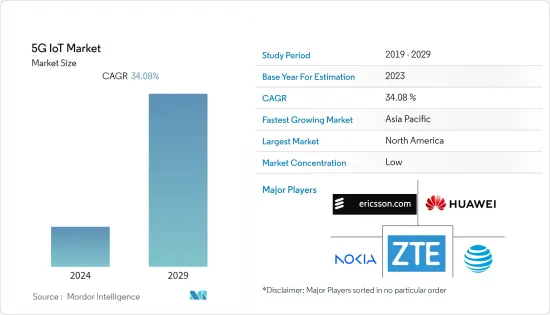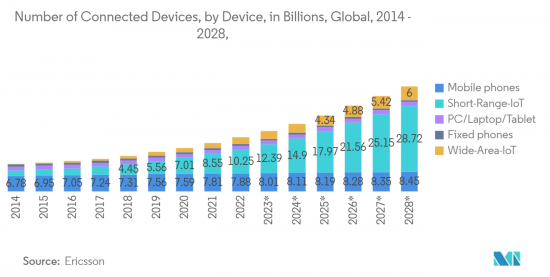 |
市場調查報告書
商品編碼
1406577
5G物聯網-市場佔有率分析、產業趨勢與統計、2024年至2029年成長預測5G IoT - Market Share Analysis, Industry Trends & Statistics, Growth Forecasts 2024 - 2029 |
||||||
※ 本網頁內容可能與最新版本有所差異。詳細情況請與我們聯繫。
今年5G物聯網市場規模預估為95.4億美元。
預計五年內市場規模將達到 558.6 億美元,預測期內複合年成長率為 34.08%。 5G 對於物聯網至關重要,因為它需要大容量、高速網路來滿足連接需求。 5G頻譜提高了蜂窩技術傳輸資料的頻率。這種廣泛的頻寬增加了行動網路的整體頻寬,允許更多設備連接。

主要亮點
- 5G 物聯網網路旨在同時支援大量連接裝置。此功能在物聯網應用中非常重要,其中許多感測器、攝影機和其他設備需要有效地通訊和交換資料。據Cisco稱,到 2022 年,北美連網穿戴裝置數量預計將達到 4.39 億台,高於 2021 年的 3.788 億台。此外,愛立信預計,2022年全球智慧型手機行動網路用戶數將達到近66億,2028年將超過78億人。
- 隨著物聯網的擴展和更多設備的互連,對可靠且強大的通訊基礎設施來支援這種大規模連接的需求日益成長。因此,5G 物聯網市場預計將大幅成長,更多產業和部門將利用 5G 的潛力來實現其物聯網雄心。
- 5G 相對於 LTE 在低延遲和關鍵應用方面的優勢使其成為需要即時資料處理和可靠連接的行業和部門的有吸引力的選擇。隨著對低延遲、關鍵物聯網應用的需求不斷增加,在這些使用案例中採用 5G 將推動 5G 物聯網市場的成長,改變各個行業並創造新的創新服務和解決方案。這將成為現實。
- 將基礎設施從 LTE 升級到 5G 的成本正在限制市場成長。雖然 5G 為物聯網應用提供了許多優勢,包括更低的延遲、更高的容量和更快的資料速度,但部署5G 網路和升級現有基礎設施的相關成本對於某些產業和地區來說尤其具有挑戰性。
- COVID-19 大流行凸顯了智慧城市解決方案對公共和城市管理的重要性。接觸者追蹤、人群監控、智慧基礎設施等5G物聯網應用受到關注。疫情期間,不少企業加快數位轉型步伐,適應新常態。這包括採用 5G 支援的物聯網解決方案來提高效率、生產力和自動化。
5G 物聯網 (IoT) 市場趨勢
汽車產業預計將經歷顯著的成長。
- 汽車產業是5G物聯網市場最重要的細分市場之一。 5G的超高速和低延遲能力可實現車輛與雲端的無縫連接,實現即時資料交換。連網型汽車可以收集有關交通狀況、天氣和道路危險的資訊,以提高安全性、改善導航並改善駕駛員輔助系統。
- 5G IoT 支援 V2X通訊,車輛可與其他車輛 (V2V)、基礎設施 (V2I)、行人 (V2P) 和網路 (V2N)通訊。這種連接改善了道路安全和交通管理,並為自動駕駛奠定了基礎。
- 5G物聯網將透過即時追蹤和監控車輛零件來改善供應鏈管理,從而改善庫存管理並減少停機時間。
- 自動駕駛汽車的成功部署高度依賴強大而可靠的網路基礎設施。 5G 的低延遲和高資料傳輸速度對於自動駕駛汽車和其他連接設備之間的即時通訊至關重要,使其成為自動駕駛汽車的關鍵推動者。
- 據愛立信稱,全球連網型設備的數量將在五年內增加一倍。這一成長預計將由短程 IoT(物聯網)設備的增加所推動,預計五年內此類設備將達到 287.2 億台。連網型設備包括穿戴式裝置、聯網汽車、智慧感測器等。

預計北美將佔據較大市場佔有率
- 北美是最早商業性部署5G網路的地區之一,各大電信業者大力投資5G基礎設施。 5G 的早期推出使該地區能夠為各種物聯網應用開發強大的生態系統。蓬勃發展
- 國內 5G 部署可能會增加對 5G 基礎設施的需求,以支援已部署的 5G 功能和服務。例如,愛立信預計,三年內5G用戶數將超過1.95億,而在美國,六年內5G將占美國行動市場總量的約71.5%。
- 該地區的工業IoT(IIoT) 解決方案在製造業、能源和公共產業等多個領域的採用日益增加。 5G的高速、低延遲連線將增強IIoT能力,實現即時資料分析和遠端監控。 CTIA表示,快速成長為美國5G經濟創造了平台。預計將帶來2,750億美元的投資,創造300萬個新就業崗位,並帶來5,000億美元的經濟成長。
- 北美多個城市正在進行智慧城市計劃,利用 5G 物聯網技術改善城市基礎設施、交通、公共安全和公民服務。
- 北美是汽車產業的中心,連網型汽車解決方案正在蓬勃發展。 5G IoT 支援先進的 V2X(車對萬物)通訊,促進更安全、更有效率的交通。
5G物聯網(IoT)產業概況
5G IoT 市場高度分散,主要企業包括諾基亞公司、AT&T 公司、華為科技公司、Telefonaktiebolaget LM Ericsson 和中興通訊公司。市場參與者正在採取聯盟和收購等策略來加強其產品供應並獲得永續的競爭優勢。
2023年6月,愛立信和Ooredoo卡達公司在Ooredoo卡達公司訪問位於瑞典希斯塔的愛立信總部期間簽署了將5G協議延長五年,以加強無線接取網路(RAN)產品和服務的合作。透過提供先進的5G RAN解決方案和服務,實現更快的資料通訊,愛立信將幫助卡達Oredoo為其用戶開拓新的5G用例和連接機會,並加速物聯網(探索人工智慧(AI)和機器學習等新技術)學習(ML)以最佳化網路效能和使用者體驗。
2023 年 2 月,思科和 NEC 宣布計劃擴大合作範圍,涵蓋 5G xHaul 和專用 5G 領域的系統整合解決方案和潛在商機。
其他福利:
- Excel 格式的市場預測 (ME) 表
- 3 個月的分析師支持
目錄
第1章簡介
- 研究假設和市場定義
- 調查範圍
第2章調查方法
第3章執行摘要
第4章市場洞察
- 市場概況
- 產業吸引力-波特五力分析
- 供應商的議價能力
- 買家/消費者的議價能力
- 新進入者的威脅
- 替代品的威脅
- 競爭公司之間的敵對關係
- 技術簡介
第5章市場動態
- 市場促進因素
- 5G 技術能夠處理數百萬個物聯網連接設備
- 5G 相對於 LTE 在低延遲和關鍵應用方面的優勢
- 市場抑制因素
- 現有 4G LTE 技術足以滿足某些物聯網使用案例。
- 將基礎設施從 LTE 升級到 5G 的成本
第6章市場區隔
- 依技術
- 超可靠低延遲通訊(URLLC)
- 低功耗廣域網路 (LPWAN)
- 按最終用戶產業
- 製造業
- 供應鏈
- 衛生保健
- 零售
- 智慧城市
- 車
- 按地區
- 北美洲
- 美國
- 加拿大
- 墨西哥
- 北美其他地區
- 歐洲
- 德國
- 英國
- 法國
- 俄羅斯
- 西班牙
- 歐洲其他地區
- 亞太地區
- 印度
- 中國
- 日本
- 其他亞太地區
- 南美洲
- 巴西
- 阿根廷
- 南美洲其他地區
- 中東/非洲
- 阿拉伯聯合大公國
- 沙烏地阿拉伯
- 非洲
- 北美洲
第7章 競爭形勢
- 公司簡介
- Nokia Corporation
- AT&T Inc.
- Huawei Technologies Co Ltd
- Telefonaktiebolaget LM Ericsson
- ZTE Corporation
- Cisco Systems Inc
- Deutsche Telekom AG(T-Mobile)
- Verizon Communication Inc
- Sprint Corp
- Vodafone Group PLC
第8章 市場機會及未來趨勢

The 5G IoT Market was valued at USD 9.54 billion in the current year. The market is expected to reach USD 55.86 billion in five years, registering a CAGR of 34.08% during the forecast period. 5G is essential to the Internet of Things because of the need for a faster network with higher capacity that can serve connectivity needs. The 5G spectrum increases the frequencies on which cellular technologies will transfer data. This broader spectrum for use increases the overall bandwidth of mobile networks, allowing additional devices to connect.
Key Highlights
- 5G IoT networks are designed to support many connected devices simultaneously. This capability is critical in IoT applications, where many sensors, cameras, and other devices need to communicate and exchange data efficiently. According to Cisco Systems, the number of connected wearable devices in North America is expected to reach 439 million by 2022 from 378.8 million in 2021. Moreover, Ericsson says the number of smartphone mobile network subscriptions globally reached almost 6.6 billion in 2022 and is forecast to exceed 7.8 billion by 2028. this is expected to drive the market further.
- As the Internet of Things expands and more devices become interconnected, there is a growing need for reliable and robust communication infrastructure to support this massive scale of connectivity. As a result, the 5G IoT market is expected to experience substantial growth, with an increasing number of industries and sectors leveraging the potential of 5G to realize their IoT ambitions.
- The advantage of 5G over LTE for low latency and critical applications makes it a compelling choice for industries and sectors that require real-time data processing and reliable connectivity. As the demand for low latency and critical IoT applications increases, the adoption of 5G for such use cases will drive the growth of the 5G IoT market, transforming various industries and enabling new innovative services and solutions.
- The cost of upgrading infrastructure from LTE to 5G restrains the market growth. While 5G offers numerous advantages for IoT applications, including low latency, increased capacity, and higher data speeds, the expenses associated with deploying 5G networks and upgrading existing infrastructure can pose challenges, especially for certain industries and regions.
- The COVID-19 pandemic underscored the importance of smart city solutions for public safety and urban management. 5G IoT applications like contact tracing, crowd monitoring, and smart infrastructure gained attention. Many businesses accelerated digital transformation initiatives during the pandemic to adapt to the new normal. This includes adopting IoT solutions enabled by 5G for improved efficiency, productivity, and automation.
5G Internet of Things (IoT) Market Trends
Automotive Industry is Expected to Witness Significant Growth Rate
- The Automotive industry was one of the most significant segments in the 5G IoT market. 5G's ultra-fast and low-latency capabilities allow for seamless connectivity between vehicles and the cloud, enabling real-time data exchange. Connected cars can gather information on traffic conditions, weather, and road hazards, enhancing safety, better navigation, and improved driver assistance systems.
- 5G IoT enables V2X communication, which allows vehicles to communicate with other vehicles (V2V), infrastructure (V2I), pedestrians (V2P), and network (V2N). This connectivity improves road safety and traffic management, creating a foundation for autonomous driving.
- 5G IoT can improve supply chain management by enabling real-time tracking and monitoring of vehicle components and parts, leading to better inventory management and reduced downtime.
- The successful deployment of autonomous vehicles heavily relies on a robust and reliable network infrastructure. 5G's low latency and high data transfer rates are crucial for real-time communication between autonomous vehicles and other connected devices, making it a key enabler for self-driving cars.
- According to Ericsson, the number of connected devices globally is set to approximately double within five years. This growth is expected to be driven by an increase in short-range IoT (Internet of Things) devices, with 28.72 billion such devices forecast in five years. Connected devices include wearables, connected cars, and smart sensors.

North America is Expected to Hold Significant Market Share
- North America was among the first regions to deploy 5G networks commercially, with significant telecommunication companies investing heavily in 5G infrastructure. The early rollout of 5G has enabled the region to develop a robust ecosystem for various IoT applications. The booming
- 5G deployments in the country will increase the demand for 5g infrastructure to support the 5G features and services being rolled out. For instance, according to Ericsson, there will be more than 195 million 5G subscriptions in three years, and in six years, in the United States, 5G will account for about 71.5% of the entire U.S. mobile market.
- The region has seen significant adoption of Industrial IoT (IIoT) solutions in various sectors, including manufacturing, energy, and utilities. 5G's high-speed, low-latency connectivity enhances the capabilities of IIoT, enabling real-time data analytics and remote monitoring. According to CTIA, rapid growth creates a platform for the United States' 5G economy. It will lead to USD 275 billion in investment and 3 million new jobs, creating USD 500 billion in economic growth.
- Several cities in North America have embarked on smart city initiatives, using 5G IoT technologies to improve urban infrastructure, transportation, public safety, and citizen services.
- North America is a hub for the automotive industry and has witnessed rapid growth in connected vehicle solutions. 5G IoT enables advanced V2X (Vehicle-to-Everything) communication, facilitating safer and more efficient transportation.
5G Internet of Things (IoT) Industry Overview
The 5G IoT Market is highly fragmented, with major players like Nokia Corporation, AT&T Inc., Huawei Technologies Co Ltd, Telefonaktiebolaget LM Ericsson, and ZTE Corporation. Players in the market are adopting strategies such as partnerships and acquisitions to enhance their product offerings and gain sustainable competitive advantage.
In June 2023, Ericsson and Ooredoo Qatar signed a five-year extension of their 5G deal during Ooredoo Qatar's visit to Ericsson's headquarters in Kista, Sweden, to increase collaboration on radio access network (RAN) products and services. Ericsson will deliver advanced 5G RAN solutions and services that enable faster data speeds, allowing Ooredoo Qatar to explore new 5G use cases and connectivity opportunities for subscribers, leverage the potential of Internet of Things (IoT) applications, and explore emerging technologies like artificial intelligence (AI), and machine learning (ML) for optimizing network performance and user experience.
In February 2023, Cisco and NEC Corporation announced plans to expand their collaboration efforts to include system integration solutions and potential opportunities in 5G xHaul and private 5G to help consumer transform their architecture and connect more people and things.
Additional Benefits:
- The market estimate (ME) sheet in Excel format
- 3 months of analyst support
TABLE OF CONTENTS
1 INTRODUCTION
- 1.1 Study Assumptions and Market Defnition
- 1.2 Scope of the Study
2 RESEARCH METHODOLOGY
3 EXECUTIVE SUMMARY
4 MARKET INSIGHTS
- 4.1 Market Overview
- 4.2 Industry Attractiveness - Porter's Five Forces Analysis
- 4.2.1 Bargaining Power of Suppliers
- 4.2.2 Bargaining Power of Buyers/Consumers
- 4.2.3 Threat of New Entrants
- 4.2.4 Threat of Substitute Products
- 4.2.5 Intensity of Competitive Rivalry
- 4.3 Technology Snapshot
5 MARKET DYNAMICS
- 5.1 Market Drivers
- 5.1.1 The Ability of 5G Technology to Handle Millions of IoT Connected Devices
- 5.1.2 Advantages of 5G over LTE for Low Latency and Critical Applications
- 5.2 Market Restraints
- 5.2.1 Existing 4G LTE Technology is Sufficient for Certain IoT Use Cases
- 5.2.2 Costs Involved in the up-gradation of the Infrastructure from LTE to 5G
6 MARKET SEGMENTATION
- 6.1 By Technology
- 6.1.1 Ultra-Reliable Low-Latency Communications (URLLC)
- 6.1.2 Low-Power Wide-Area Network (LPWAN)
- 6.2 By End-User Industry
- 6.2.1 Manufacturing
- 6.2.2 Supply Chain
- 6.2.3 Healthcare
- 6.2.4 Retail
- 6.2.5 Smart Cities
- 6.2.6 Automotive
- 6.3 By Geography
- 6.3.1 North America
- 6.3.1.1 United States
- 6.3.1.2 Canada
- 6.3.1.3 Mexico
- 6.3.1.4 Rest of North America
- 6.3.2 Europe
- 6.3.2.1 Germany
- 6.3.2.2 United Kingdom
- 6.3.2.3 France
- 6.3.2.4 Russia
- 6.3.2.5 Spain
- 6.3.2.6 Rest of Europe
- 6.3.3 Asia Pacific
- 6.3.3.1 India
- 6.3.3.2 China
- 6.3.3.3 Japan
- 6.3.3.4 Rest of Asia Pacific
- 6.3.4 South America
- 6.3.4.1 Brazil
- 6.3.4.2 Argentina
- 6.3.4.3 Rest of South America
- 6.3.5 Middle East and Africa
- 6.3.5.1 UAE
- 6.3.5.2 Saudi Arabia
- 6.3.5.3 Africa
- 6.3.1 North America
7 COMPETITIVE LANDSCAPE
- 7.1 Company Profiles
- 7.1.1 Nokia Corporation
- 7.1.2 AT&T Inc.
- 7.1.3 Huawei Technologies Co Ltd
- 7.1.4 Telefonaktiebolaget LM Ericsson
- 7.1.5 ZTE Corporation
- 7.1.6 Cisco Systems Inc
- 7.1.7 Deutsche Telekom AG (T-Mobile)
- 7.1.8 Verizon Communication Inc
- 7.1.9 Sprint Corp
- 7.1.10 Vodafone Group PLC













